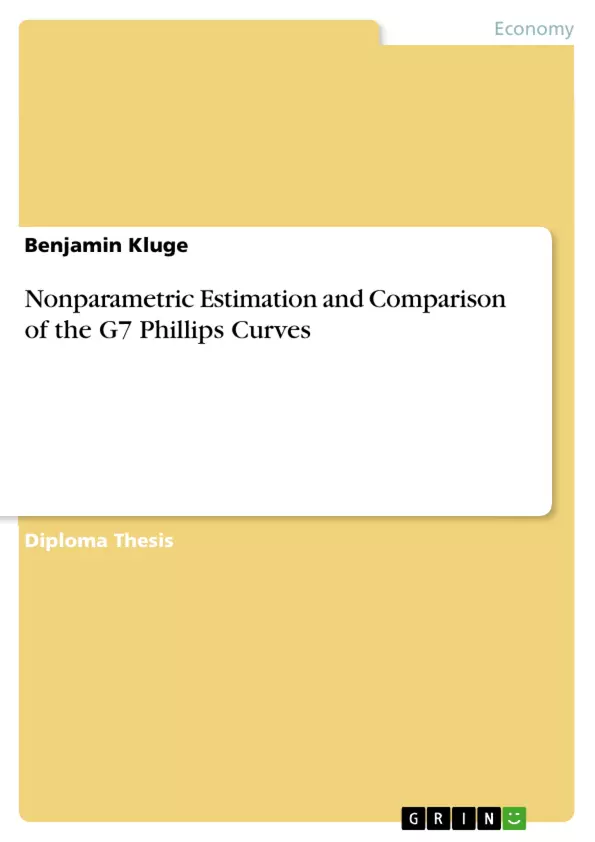Ziel der Arbeit ist es den seit langem wissenschaftlich diskutierten Zusammenhang zwischen Inflation und Arbeitslosigkeit, die Phillips-Kurve, mit Hilfe neuer statistischer Methoden zu untersuchen und seine verschiedenen Ausprägungen bei den G7-Staaten miteinander zu vergleichen. Dabei werden zwei weitere Einflüsse, Produktivität und Inflationsklima, miteinbezogen.
Der erste Teil führt in die Diskussion der Phillips-Kurve ein. Im Folgenden werden die zur Analyse notwendigen Nichtparametrischen Verfahren vorgestellt und eingehend beschrieben. Die Analyse und der Vergleich der G7-Phillips-Kurven wird im vierten Kapitel durchgeführt. Im Anschluss daran folgt eine Zusammenfassung der Ergebnisse und ein Ausblick.
Inhaltsverzeichnis (Table of Contents)
- Introduction
- Remarks on the Phillips Curve
- Historical Review
- Phillips original curve and the time before
- Lipsey's excess demand and the first PC for the USA
- The critiques and the failure of the curve.
- Summary of the Contemporary Debate - State of the Art
- Discussion of Important PC Issues
- Demand pull and cost push
- Closed economy vs. open economy
- Modeling two involved markets
- Expectations
- Proportional, derivative, and integral terms
- Nonlinear behavior
- Constant vs. time varying NAIRU
- Other influences.
- Wage and Price Phillips Curves: The Empirical Framework.
- Issues to be Investigated
- Historical Review
- Semiparametric Regression
- Some Introductory Words
- Parametric Regression
- Linear regression
- Polynomial and nonlinear regression
- Neighborhood Smoothing.
- Locally-weighted running line smoother.
- Kernel smoother
- The Spline Smoothing Approach.
- Regression splines.
- Knot selection and a roughness penalty
- Smoothing splines. .
- Natural cubic splines
- Additive Models.
- Choice of a Smoothing Model
- Model selection
- Automatic smoothing parameter selection
- Analysis and Comparison of International Phillips Curves
- Introduction
- Preliminary Considerations.
- Seasonal adjusted data
- The sense of multi-dimensionality
- Wage-price spiral
- The disregard of significant factors
- The Data
- Traditional 2D-view of the Two Markets
- OLS Estimation of the Model Equations
- Nonparametric Analysis: Fitting a GAM
- Summary of the Results
- Conclusion and Outlook
Zielsetzung und Themenschwerpunkte (Objectives and Key Themes)
This diploma thesis aims to analyze the Phillips Curve in a nonparametric framework. The focus is on examining the relationship between inflation and unemployment for the G7 countries, using semiparametric regression techniques. The study seeks to investigate the existence and characteristics of the Phillips Curve in a modern context, considering the complexities of the relationship and exploring potential deviations from traditional models.- Empirical analysis of the Phillips Curve for G7 countries
- Application of semiparametric regression techniques, particularly Generalized Additive Models (GAM)
- Comparison of nonparametric results with traditional Ordinary Least Squares (OLS) estimates
- Evaluation of the impact of factors like expectations, globalization, and structural changes on the Phillips Curve relationship
- Investigation of potential differences in the Phillips Curve across G7 countries
Zusammenfassung der Kapitel (Chapter Summaries)
- Introduction: This chapter provides an overview of the research question and the context of the study, highlighting the importance of the Phillips Curve in macroeconomic theory and policy.
- Remarks on the Phillips Curve: This chapter delves into the historical evolution of the Phillips Curve, examining its origins, critiques, and the ongoing debate surrounding its validity. It discusses key factors influencing the relationship between inflation and unemployment, such as expectations, global economic conditions, and structural changes.
- Semiparametric Regression: This chapter presents the theoretical foundation of semiparametric regression, focusing on the use of Generalized Additive Models (GAMs) to analyze the relationship between inflation and unemployment. It explores the advantages and limitations of this approach compared to traditional parametric methods.
- Analysis and Comparison of International Phillips Curves: This chapter analyzes the Phillips Curve for G7 countries, using both traditional Ordinary Least Squares (OLS) and nonparametric GAM techniques. It compares the results and discusses the implications for macroeconomic policy.
Schlüsselwörter (Keywords)
The key focus of this work lies in the empirical analysis of the Phillips Curve for the G7 countries. This includes the application of nonparametric regression techniques, particularly Generalized Additive Models (GAMs), and their comparison with traditional Ordinary Least Squares (OLS) estimations. The study explores the impact of various factors on the Phillips Curve relationship, such as expectations, globalization, and structural changes, while also investigating potential differences in the Phillips Curve across G7 countries. Keywords include: Phillips Curve, nonparametric regression, Generalized Additive Models (GAM), Ordinary Least Squares (OLS), G7 countries, inflation, unemployment, expectations, globalization, structural changes.- Citation du texte
- Benjamin Kluge (Auteur), 2004, Nonparametric Estimation and Comparison of the G7 Phillips Curves, Munich, GRIN Verlag, https://www.grin.com/document/186478



